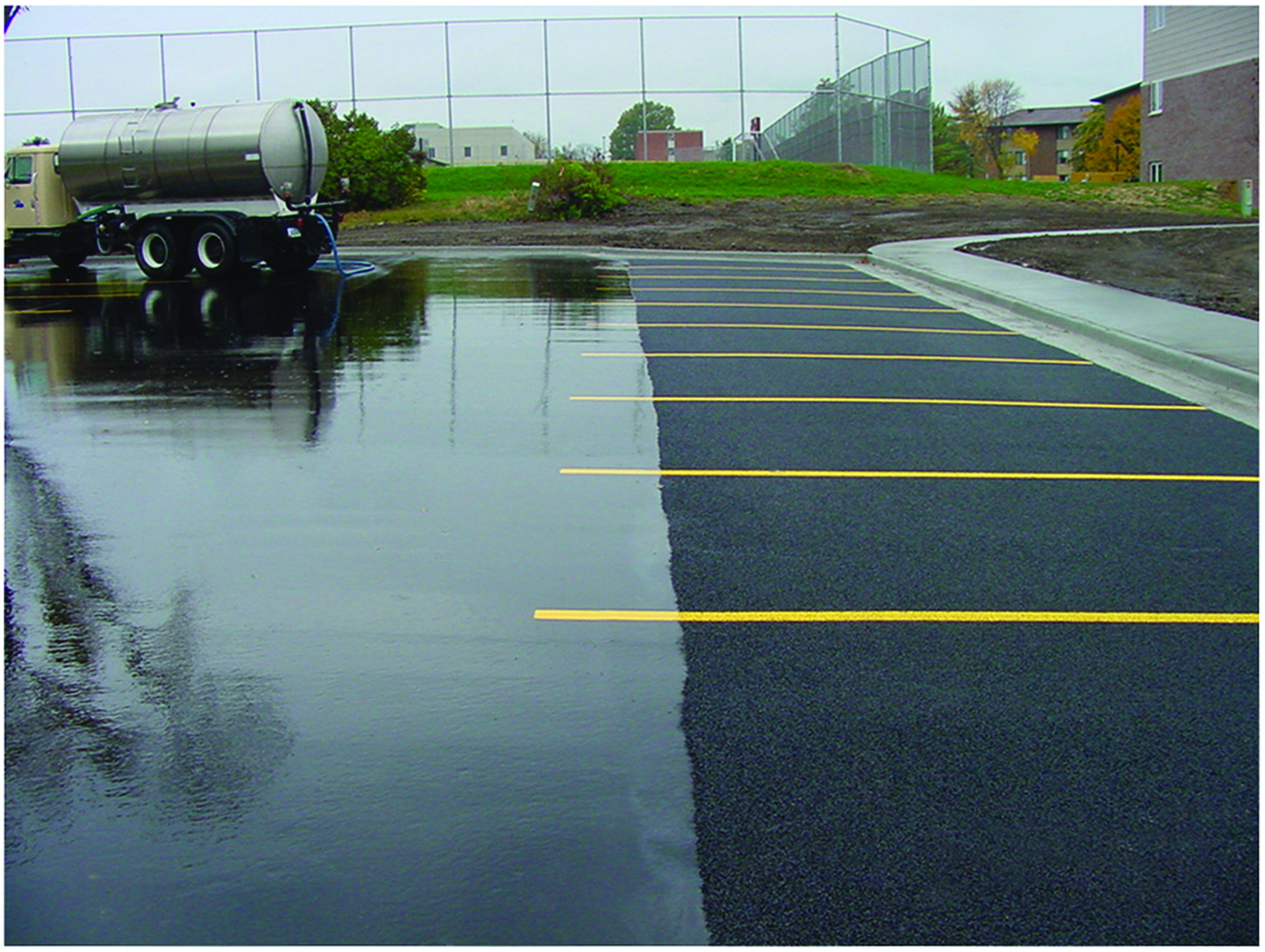Paving and Asphalt
Use Porous Asphalt
What Is It?

LL Pelling, co.
Porous asphalt is open-graded asphalt mixed with less sand and fine particles than conventional asphalt and is laid above crushed stone aggregate layer to allow for water infiltration, making it a Stormwater Management best practice by the US EPA. Water is able to permeate the asphalt due to increased void space of (approx. 16% compared to 2-3% for conventional asphalt). In order to maintain infiltration, porous asphalt should not be used on slopes of greater than 5%.
The infiltration rate ranges from hundreds of inches per hour when freshly paved to more than one inch per hour when the void spaces are clogged. Proper maintenance (primarily vacuum sweeping) is necessary to maintain high rates of infiltration. Potholes and cracks can be fixed with patching mixes unless >10% of the surface needs replacement. Infiltration rates are also highly dependent on the subgrade soil. Sandy soils have higher infiltration rates, but lower treatment capacity. Conversely, clay soils capture more pollutants, but have lower infiltration rates. In case of low permeability subgrade soils (<0.25 in/hr), installing underdrains or combining pavement with infiltration trenches or bioswales can improve drainage.
Benefits
- Enhances groundwater infiltration while reducing stormwater runoff volume, rate, and pollutants
- On roadways, can reduce skidding, hydroplaning, and other surface water-related accidents, since water generally does not remain on the surface
- Can contribute to lower urban air temperatures when moist due to higher reflectivity and evaporative cooling; this also combats Urban Heat Island effect because the air and water exchange from the pavement to the soil beneath keeps the surface cooler
- A more natural exchange of water flow into the ground and cooler surface temperatures promotes plant growth, which further regulates temperatures, removes CO2 from the air, and looks pleasing
- Reduces occurrence of black ice/freezing puddles in cold climates; requires less applied de-icers
- Higher frictional resistance allows for better traction than conventional asphalt in cold climates
Drawbacks
- Pollutants and deicing salts can infiltrate groundwater—should not be installed in areas where hazardous material spills are possible
- Plowed snow piles and improper de-icing treatment can clog void spaces and reduce infiltration rate (sand should not be used); snow plow blades can damage surface
Regulatory Impacts and Requirements
Potential regulatory touchpoints in Boston and Massachusetts include:
- Boston Groundwater Trust
- Boston Water and Sewer Commission
- Local Utilities
- Boston Public Works Department
- Public Improvement Commission
- Zoning Board of Appeals
- Architectural Access Board
- MA Historical Commission/Boston Landmarks Commission
Other
- Nearby buildings: When installing permeable pavement, it is critical to conduct subsurface investigation. There are many old vaults with direct access to building basements underneath Boston sidewalks that could potentially leak water into the building if permeable pavement is installed at the surface. Many of these vaults are unmapped and there are legal issues around who owns the vault and the sidewalk/sub-base above it. In addition, rubble foundations and other old building foundations nearby may begin to leak from increased hydrostatic pressure.
- Groundwater Trust: Installation of permeable pavements in the Groundwater Conservation Overlay District (GCOD) may require consultation with the Groundwater Trust. In particular, permeable pavements cannot be installed over polluted sites within GCOD.
Financing Options, Incentives, and Rebates
- Mass.gov:
- Clean Water State Revolving Fund (SRF)
- Coastal Pollutant Remediation (CPR) Grant Program
- Section 319 Nonpoint Source Competitive Grant (Funding provided under federal Clean Water Act)
- 604b Water Quality Management Planning Grant (Funding provided under federal Clean Water Act)
- Drinking Water Supply Protection Grant Program
- Newton, MA: Municipal stormwater abatement service fees
Resources:
- US DOT, Federal Highway Administration: Porous Asphalt Pavements with Stone Reservoirs
- National Asphalt Pavement Association: Porous Asphalt Pavements
- UNH Stormwater Center: Porous Asphalt factsheet
- Asphalt Pavement Association of Oregon: Porous Asphalt Pavement
- Dauphin County Conservation District: Best Management Practices Fact Sheet: Porous Asphalt
- Asphalt Institute: “Porous asphalt is key to integrated storm water management”
- California Coastal Commission: Permeable Pavement
- US EPA: See pg. 8 of the Cooling Pavements Chapter of their Heat Island Compendium
- Seattle Right of Way Manual: Permeable Pavement Comparison Guide
- University of Maryland: Permeable Pavement Fact Sheet
News:
- “Permeable Solutions to Reducing Standing Water, Stormwater Runoff,” Press of Atlantic City, April 2016
- “Kenilworth Ready to Go with Porous Asphalt, Green Street Tech,” Chicago Tribune, December 2015
Project Examples:
- The USGS monitored new installation of several permeable pavements, including porous asphalt, on Silver Lake Beach Parking Lot, Wilmington, MA.
- South End Alley 543, South End Boston, MA, helps filter and minimize runoff to the Charles River.
- One of the oldest examples of porous asphalt is the still-functional parking lot at Walden Pond, Concord, MA, which was installed in 1977.
A Sample of Providers:
- Whittier Paving
- Massachusetts and New Hampshire
- GSC Paving
- Massachusetts


